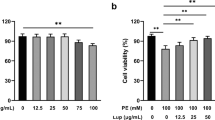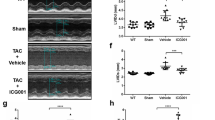Abstract
Activation of NF-κB contributes to cardiac hypertrophy and the interleukin-1 receptor (IL-1R)-mediated MyD88-dependent signaling pathway predominately activates NF-κB. Recent studies have shown that the TIR/BB-Loop mimetic (AS-1) disrupted the interaction of MyD88 with the IL-1R, resulting in blunting of NF-κB activation. We have examined the effects of AS-1 on the IL-1β-induced hypertrophic response using cultured neonatal cardiac myocytes in vitro and transverse aortic constriction (TAC) pressure overload-induced cardiac hypertrophy in vivo. Neonatal cardiac myocytes were treated with AS-1 15 min prior to IL-1β stimulation for 24 h. AS-1 treatment significantly attenuated IL-1β-induced hypertrophic responses of cardiac myocytes. In vivo experiments showed that AS-1 administration prevented cardiac hypertrophy and dysfunction induced by pressure overload. AS-1 administration disrupted the interaction of IL-1R with MyD88 in the pressure overloaded hearts and prevented activation of NF-κB. In addition, AS-1 prevented increases in activation of the MAPK pathway (p38 and p-ERK) in TAC-induced hypertrophic hearts. Our data suggest that the IL-1R-mediated MyD88-dependent signaling pathway plays a role in the development of cardiac hypertrophy and AS-1 attenuation of cardiac hypertrophy is mediated by blocking the interaction between IL-1R and MyD88, resulting in decreased NF-κB binding activity and decreased MAPK activation.






Similar content being viewed by others
References
Baldeviano GC, Barin JG, Talor MV, Srinivasan S, Bedja D, Zheng D, Gabrielson K, Iwakura Y, Rose NR, Cihakova D (2010) Interleukin-17A is dispensable for myocarditis but essential for the progression to dilated cardiomyopathy. Circ Res 106:1646–1655
Bartfai T, Behrens MM, Gaidarova S, Pemberton J, Shivanyuk A, Rebek J Jr (2003) A low molecular weight mimic of the Toll/IL-1 receptor_resistance domain inhibits IL-1 receptor-mediated responses. Proc Natl Acad Sci USA 100:7971–7976
Cao Z, Hu Y, Wu W, Ha T, Kelley J, Deng C, Chen Q, Li C, Li J, Li Y (2009) The TIR/BB-loop mimetic AS-1 protects the myocardium from ischaemia/reperfusion injury. Cardiovasc Res 84:442–451
Chorianopoulos E, Heger T, Lutz M, Frank D, Bea F, Katus HA, Frey N (2010) FGF-inducible 14-kDa protein (Fn14) is regulated via the RhoA/ROCK kinase pathway in cardiomyocytes and mediates nuclear factor-kappaB activation by TWEAK. Basic Res Cardiol 105:301–313
Clerk A, Sugden PH (2001) Untangling the web: specific signaling from PKC isoforms to MAP cascades. Circ Res 89:847–849
Davis CN, Mann E, Behrens MM, Gaidarova S, Rebek M, Rebek J Jr, Bartfai T (2006) MyD88-dependent and -independent signaling by IL-1 in neurons probed by bifunctional Toll/IL-1 receptor domain/BB-loop mimetics. Proc Natl Acad Sci USA 103:2953–2958
Dinarello CA (2010) IL-1: discoveries, controversies and future directions. Eur J Immunol 40:599–606
Esposito G, Prasad SV, Rapacciuolo A, Mao L, Koch WJ, Rockman HA (2001) Cardiac overexpression of a G(q) inhibitor blocks induction of extracellular signal-regulated kinase and c-Jun NH(2)-terminal kinase activity in in vivo pressure overload. Circulation 13:1453–1458
Feng JA, Perry G, Mori T, Hayashi T, Oparil S, Chen YF (2003) Pressure-independent enhancement of cardiac hypertrophy in atrial natriuretic peptide-deficient mice. Clin Exp Pharmacol Physiol 30:343–349
Fremond CM, Togbe D, Doz E, Rose S, Vasseur V, Maillet I, Jacobs M, Ryffel B, Quesniaux VF (2007) IL-1 receptor-mediated signal is an essential component of MyD88-dependent innate response to Mycobacterium tuberculosis infection. J Immunol 179:1178–1189
Gupta S, Young D, Maitra RK, Gupta A, Popovic ZB, Yong SL, Mahajan A, Wang Q, Sen S (2008) Prevention of cardiac hypertrophy and heart failure by silencing of NF-kappaB. J Mol Biol 375:637–649
Ha T, Hua F, Li Y, Ma J, Gao X, Kelley J, Zhao A, Haddad GE, Williams DL, Browder IW, Kao RL, Li C (2006) Blockade of MyD88 attenuates cardiac hypertrophy and decreases cardiac myocyte apoptosis in pressure overload-induced cardiac hypertrophy in vivo. Am J Physiol Heart Circ Physiol 290:H985–H994
Heusch G, Schulz R (2011) A radical view on the contractile machinery in human heart failure. J Am Coll Cardiol 57:310–312
Honsho S, Nishikawa S, Amano K, Zen K, Adachi Y, Kishita E, Matsui A, Katsume A, Yamaguchi S, Nishikawa K, Isoda K, Riches DW, Matoba S, Okigaki M, Matsubara H (2009) Pressure-mediated hypertrophy and mechanical stretch induces IL-1 release and subsequent IGF-1 generation to maintain compensative hypertrophy by affecting Akt and JNK pathways. Circ Res 20:1149–1158
Hu Y, Li T, Wang Yi, Guo L, Shan X, Li J, Chen Q, Li Y (2007) IL-1RI/MyD88-TIR mimic AS-1 inhibits the activation of MyD88-dependent signaling pathway induced by IL-1β in vitro. JNMU 21:354–358
Kleinbongard P, Heusch G, Schulz R (2010) TNFalpha in atherosclerosis, myocardial ischemia/reperfusion and heart failure. Pharmacol Ther 127:295–314
LaMorte VJ, Thorburn J, Absher D, Spiegel A, Brown JH, Chien KR, Feramisco JR, Knowlton KU (1994) Gq- and/Ras-dependent pathways mediate hypertrophy of neonatal rat ventricular myocytes following α1-adrenergic stimulation. J Biol Chem 269:13490–13496
Li T, Wang YM, Liu CY, Hu YL, Wu ML, Li J, Guo L, Chen L, Chen Q, Ha TZ, Li CF, Li YH (2009) MyD88-dependent NFκB activation is involved in fibrinogen-induced hypertrophic response of cardiomyocytes. J Hypertens 27:1084–1093
Li Y, Ha T, Kelley J, Gao X, Browder W, Williams D, Kao RL, Li C (2004) NF-κB activation is required for the development of cardiac hypertrophy in vivo. Am J Physiol Heart Circ Physiol 287:1712–1720
Long CS (2001) The role of interleukin-1 in the failing heart. Heart Fail Rev 6:81–94
Loppnow H, Werdan K, Reuter G, Flad H-D (1998) The interleukin-1 and interleukin-1-converting enzyme families in the cardiovascular system. Eur Cytokine Netw 9:675–680
MacIver DH (2010) Is remodeling the dominant compensatory mechanism in both chronic heart failure with preserved and reduced left ventricular ejection fraction? Basic Res Cardiol 105:227–234
Michel MC, Li Y, Heusch G (2001) Mitogen-activated protein kinases in the heart. Naunyn-Schmiedeberg’s Arch Pharmacol 363:245–266
Morisugi T, Tanaka Y, Kawakami T, Kirita T (2010) Mechanical stretch enhances NF-kappaB-dependent gene expression and poly(ADP-ribose) synthesis in synovial cells. J Biochem 147:633–644
Palmer JN, Hartogensis WE, Patten M, Fortuin FD, Long CS (1995) Interleukin-1 beta induces cardiac myocyte growth but inhibits cardiac fibroblast proliferation in culture. J Clin Invest 95:2555–2564
Shimbo D, Muntner P, Mann D, Barr RG, Tang W, Post W, Lima J, Burke G, Bluemke D, Shea S (2011) Association of left ventricular hypertrophy with incident hypertension: the multi-ethnic study of atherosclerosis. Am J Epidemiol 173:898–905
Shioi T, Matsumori A, Kihara Y, Inoko M, Ono K, Iwanaga Y, Yamada T, Iwasaki A, Matsushima K, Sasayama S (1997) Increased expression of interleukin-1β and monocyte chemotactic and activating factor/monocyte chemoattractant protein-1 in the hypertrophied and failing heart with pressure overload. Circ Res 81:664–671
Akira Shizuo, Takeda Kiyoshi (2004) Toll-like receptor signalling. Nat Rev Immunol 4:499–511
Streicher JM, Ren S, Herschman H, Wang Y (2010) MAPK-activated protein kinase-2 in cardiac hypertrophy and cyclooxygenase-2 regulation in heart. Circ Res 30:1434–1443
Trocha S, Drusco A, Gu Y, Russo MA, Frati G, Jones SP, Lefer DJ, Napoli C, Croce CM (2001) Heart-targeted overexpression of caspase3 in mice increases infarct size and depresses cardiac function. Proc Natl Acad Sci USA 98:9977–9982
Valeur HS, Valen G (2009) Innate immunity and myocardial adaptation to ischemia. Basic Res Cardiol 104:22–32
Vanderheyden M, Paulus WJ, Voss M, Knuefermann P, Sivasubramanian N, Mann D, Baumgarten G (2005) Myocardial cytokine gene expression is higher in aortic stenosis than in idiopathic dilated cardiomyopathy. Heart 91:926–931
van Empel VP, Bertrand AT, van Oort RJ, van der Nagel R, Engelen M, van Rijen HV, Doevendans PA, Crijns HJ, Ackerman SL, Sluiter W, De Windt LJ (2006) EUK-8, a superoxide dismutase and catalase mimetic, reduces cardiac oxidative stress and ameliorates pressure overload-induced heart failure in the harlequin mouse mutant. J Am Coll Cardiol 48:824–832
Volz HC, Seidel C, Laohachewin D, Kaya Z, Müller OJ, Pleger ST, Lasitschka F, Bianchi ME, Remppis A, Bierhaus A, Katus HA, Andrassy M (2010) HMGB1: the missing link between diabetes mellitus and heart failure. Basic Res Cardiol 105:805–820
Wang Y (2001) Signal transduction in cardiac hypertrophy-dissecting compensatory versus pathological pathways utilizing a transgenic approach. Curr Opin Pharmacol 1:134–140
Xia Y, Lee K, Li N, Corbett D, Mendoza L, Frangogiannis NG (2009) Characterization of the inflammatory and fibrotic response in a mouse model of cardiac pressure overload. Histochem Cell Biol 131:471–481
Acknowledgments
This work was supported by the National Natural Science Foundation of China (No. 30571842, No. 30971258 to Dr. Yuehua Li, No. 30730044 to Dr. Qi Chen).
Conflict of interest
None.
Author information
Authors and Affiliations
Corresponding author
Additional information
Y. Zhu and T. Li contributed equally to the work.
Rights and permissions
About this article
Cite this article
Zhu, Y., Li, T., Song, J. et al. The TIR/BB-loop mimetic AS-1 prevents cardiac hypertrophy by inhibiting IL-1R-mediated MyD88-dependent signaling. Basic Res Cardiol 106, 787–799 (2011). https://doi.org/10.1007/s00395-011-0182-z
Received:
Revised:
Accepted:
Published:
Issue Date:
DOI: https://doi.org/10.1007/s00395-011-0182-z




